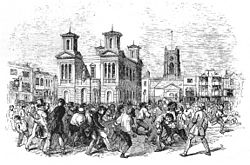칸나비놀
Cannabinol | |
 | |
| 임상 데이터 | |
|---|---|
| 루트 행정부. | 경구, 흡입 |
| ATC 코드 |
|
| 법적 상태 | |
| 법적 상태 |
|
| 식별자 | |
| |
| CAS 번호 | |
| PubChem CID | |
| IUPHAR/BPS | |
| 켐스파이더 | |
| 유니 | |
| 케그 | |
| 첸블 | |
| CompTox 대시보드 (EPA ) | |
| ECHA 정보 카드 | 100.216.772 |
| 화학 및 물리 데이터 | |
| 공식 | C21H26O2 |
| 몰 질량 | 310.437 g/120−1 |
| 3D 모델(JSmol) | |
| 녹는점 | 77°C(171°F) |
| 물에 녹는 정도 | 메탄올[3] 및[4] 에탄올 mg/mL(20°C)에 용해되는 물에[2] 불용성 |
| |
| |
| | |
CBN(Cannabinol)은 Cannabis에서 [8]미량으로 발견되는 CB1보다[5][6][7] CB2에 대한 선택성이 더 높은 카나비노이드 수용체에 결합하는 가벼운 정신 활성 카나비노이드이다.CBN은 주로 숙성되고 저장되는 대마초에서 발견되며, 식물의 주요 정신 반응 화학 물질인 테트라히드로카나비놀(THC)[9][10]에서 유래한다.
1800년대 후반에 대마초 추출물에서 분리된 최초의 대마초 화합물이었다.이것의 구조와 화학 합성은 [11]1940년에 이루어졌다.
형성
Delta-9-THC는 [12][13]산화에 의해 CBN으로 분해될 수 있다.
약리학
CBN은 CB 수용체에서1 부분작용제로 작용하지만, CB 수용체에 대한2 친화력은 높지만 THC에 비해 [14][15][16]친화력은 낮다.THC 수용체와 CBN 수용체는 모두 CB([17]Ki = 211.2nM) 수용체와2 CB(Ki = 126.4nM) 수용체를1 활성화한다.11-OH-CBN으로 대사되며, 11-OH-CBN은 CBN보다 강력한1 CB 작용제이지만 [18]CB에서 약한2 길항제 역할을 한다.
화학
THC와 달리 CBN은 이중결합 이성질체도 입체 이성질체도 없다.
CBN은 [19]산화에 의해 HU-345로 분해될 수 있습니다.
법적 상태
CBN은 1961년부터 UN의 마약 단일협약이나 [20]1971년부터의 향정신성 물질 협약에 의해 정해진 스케줄에 기재되어 있지 않기 때문에, 이러한 국제 약물 관리 조약의 가맹국은 CBN을 규제할 필요가 없다.
미국
2021년 현재 미국에서는 CBN 및 기타 대마초 추출물이 의료용으로 처방되거나 식이 보충제 또는 기타 [21][22][23]식품의 성분으로 사용되는 것은 연방법에 따라 불법이며, CBN의 판매 또는 소지는 연방 아날로그법에 [24]따라 기소될 수 있다.2016년 12월, Drug Enforcement Administration은 "분리된 수지를 제외한 칸나비스속 식물에서 파생된 하나 이상의 칸나비노이드를 포함한 추출물"로 정의되는 마리화나 추출물을 부칙 [25]I에 추가했다.
레퍼런스
- ^ 화학 중의 칸나비놀IDplus 데이터베이스
- ^ David R. Lide (2012). CRC Handbook of Chemistry and Physics. CRC Press. pp. 3–90. ISBN 978-1-43988049-4.
- ^ Sigma-Aldrich Co., Cannabinol 용액, 메탄올 1.0mg/mL, 의약품 분석용 표준.
- ^ Biotrend: Cannabinol 2016-05-22 Wayback Machine 아카이브 완료(PDF: 21kB)
- ^ Rhee, Man-Hee; Vogel, Zvi; Barg, Jacob; Bayewitch, Michael; Levy, Rivka; Hanuš, Lumir; Breuer, Aviva; Mechoulam, Raphael (1997). "Cannabinol Derivatives: Binding to Cannabinoid Receptors and Inhibition of Adenylylcyclase". Journal of Medicinal Chemistry. 40 (20): 3228–3233. doi:10.1021/jm970126f. PMID 9379442.
- ^ Sampson, Peter B. (2021). "Phytocannabinoid Pharmacology: Medicinal Properties of Cannabis sativa Constituents Aside from the "Big Two"". Journal of Natural Products. 84 (1): 142–160. doi:10.1021/acs.jnatprod.0c00965. PMID 33356248. S2CID 229694293.
- ^ "NCI Thesaurus".
- ^ Morales, Paula; Hurst, Dow P.; Reggio, Patricia H. (2017). Molecular Targets of the Phytocannabinoids: A Complex Picture. Progress in the Chemistry of Organic Natural Products. Vol. 103. pp. 103–131. doi:10.1007/978-3-319-45541-9_4. ISBN 978-3-319-45539-6. ISSN 2191-7043. PMC 5345356. PMID 28120232.
- ^ Kroner GM, Johnson-Davis KL, Doyle K, McMillin GA (May 2020). "Cannabinol (CBN) Cross-Reacts with Two Urine Immunoassays Designed to Detect Tetrahydrocannabinol (THC) Metabolite". The Journal of Applied Laboratory Medicine. 5 (3): 569–574. doi:10.1093/jalm/jfaa020. PMID 32445358.
- ^ Andre CM, Hausman JF, Guerriero G (2016-02-04). "Cannabis sativa: The Plant of the Thousand and One Molecules". Frontiers in Plant Science. 7: 19. doi:10.3389/fpls.2016.00019. PMC 4740396. PMID 26870049.
- ^ Pertwee RG (January 2006). "Cannabinoid pharmacology - the first 66 years". British Journal of Pharmacology. 147 (Suppl 1): S163-71. doi:10.1038/sj.bjp.0706406. PMC 1760722. PMID 16402100.
Cannabinol (CBN; Figure 1), much of which is thought to be formed from THC during the storage of harvested cannabis, was the first of the plant cannabinoids (phytocannabinoids) to be isolated, from a red oil extract of cannabis, at the end of the 19th century. Its structure was elucidated in the early 1930s by R.S. Cahn, and its chemical synthesis first achieved in 1940 in the laboratories of R. Adams in the U.S.A. and Lord Todd in the U.K.
- ^ Garrett, Edward R.; Gouyette, Alain J.; Roseboom, Hendrik (1978). "Stability of Tetrahydrocannabinols II". Journal of Pharmaceutical Sciences. 67: 27–32. doi:10.1002/jps.2600670108.
- ^ Cannabinoid Pharmacology. 18 August 2017. ISBN 9780128112335.
- ^ Mahadevan A, Siegel C, Martin BR, Abood ME, Beletskaya I, Razdan RK (October 2000). "Novel cannabinol probes for CB1 and CB2 cannabinoid receptors". Journal of Medicinal Chemistry. 43 (20): 3778–85. doi:10.1021/jm0001572. PMID 11020293.
- ^ Petitet F, Jeantaud B, Reibaud M, Imperato A, Dubroeucq MC (1998). "Complex pharmacology of natural cannabinoids: evidence for partial agonist activity of delta9-tetrahydrocannabinol and antagonist activity of cannabidiol on rat brain cannabinoid receptors". Life Sciences. 63 (1): PL1-6. doi:10.1016/S0024-3205(98)00238-0. PMID 9667767.
- ^ "NIA National Cancer Institute; NCIthesaurus". Cannabinol (Code C84510).
- ^ Russo EB, Marcu J (2017). "Cannabis Pharmacology: The Usual Suspects and a Few Promising Leads". Cannabinoid Pharmacology. Advances in Pharmacology. Vol. 80. pp. 67–134. doi:10.1016/bs.apha.2017.03.004. ISBN 9780128112328. PMID 28826544.
- ^ Rhee MH, Vogel Z, Barg J, Bayewitch M, Levy R, Hanus L, Breuer A, Mechoulam R (September 1997). "Cannabinol derivatives: binding to cannabinoid receptors and inhibition of adenylylcyclase". Journal of Medicinal Chemistry. 40 (20): 3228–33. doi:10.1021/jm970126f. PMID 9379442.
- ^ Kogan, Natalya M.; Peters, Maximilian; Mechoulam, Raphael (2021). "Cannabinoid Quinones—A Review and Novel Observations". Molecules. 26 (6): 1761. doi:10.3390/molecules26061761. PMC 8003933. PMID 33801057.
- ^ 국제 마약 규제 조약
- ^ Mead A (2019-06-14). "Legal and Regulatory Issues Governing Cannabis and Cannabis-Derived Products in the United States". Frontiers in Plant Science. 10: 697. doi:10.3389/fpls.2019.00697. PMC 6590107. PMID 31263468.
- ^ Mead A (May 2017). "The legal status of cannabis (marijuana) and cannabidiol (CBD) under U.S. law". Epilepsy & Behavior. 70 (Pt B): 288–291. doi:10.1016/j.yebeh.2016.11.021. PMID 28169144.
- ^ § 1308.11 부칙 I.
- ^ Erowid Analog Law Vault: 연방규제물질 아날로그법 요약
- ^ "Establishment of a New Drug Code for Marihuana Extract" (PDF). Federal Register, Vol. 81, No. 240. December 14, 2016.
외부 링크
- 칸나비스 사티바에서 발견된 에로위드 화합물



